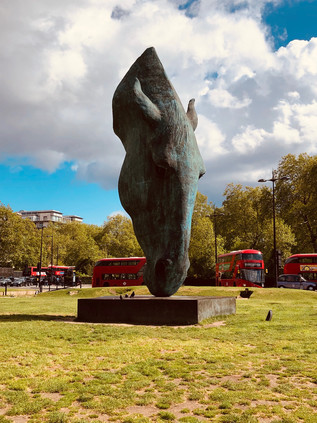There is far less excuse for this fragment lying incomplete, dating as it does from the tail end of Summer 2019. Looking back, that feels like a strangely gentle time in the world - though it was already a bubbling pot of future horror: looming and contentious US elections, the last desperate flaps of the dead Brexit fish, and interminable local politics. I remember little of the motivation given the time which has elapsed since I struck out from Liverpool Street that morning, but I clearly wanted a walk in the northeastern corner of the city and was looking for an excuse to visit Waltham Abbey. Despite my incomprehensible notes which indicated a plan to write around the link between the last resting place of King Harold Godwinson to our excursion to the statue of Edith and Harold at St.Leonards, I'd written nothing - and all that is here are some rather drab pictures of a slog into London from the fringes.
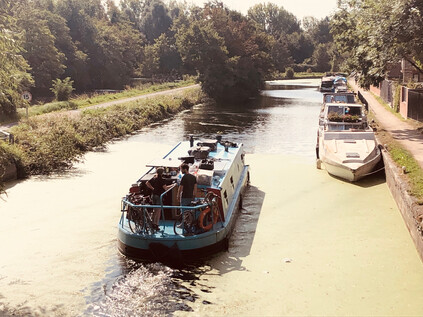
The walk out to Waltham Abbey was long and hot as I recall, and I thought I'd maybe extended myself too far until the abbey appeared squat and ancient in the middle of the small town. After a visit to Harold's grave site, I returned to the larger centre of Waltham Cross, turning south onto the pedestrianised precinct which eventually became the A1010 - the former route of the mighty A10, and of course historically, of Roman Ermine Street.. The M25 enters Holmesdale Tunnel here, with a long linear park filling the tell-tale gap between Waltham Abbey and Enfield, on land which was formerly market garden territory.
Once into Enfield, the road assumes the rather forlorn appearance of a once mighty artery now reduced to secondary importance. It becomes a string of localities, with little to distinguish them: Turkey Street, Enfield Highway, Freezywater - aside from the effort which the Borough has gone to in supporting each little commercial zone with maps, signage and 'welcome' signs. I dread to think how many of these tiny concerns managed to ride out the pandemic - though perhaps our collective 'staying local' helped some of them. The route crossed a good deal of familiar territory too - the valleys of the Turkey Brook, Salmon's Brook and Moselle, and the unnatural chasm of the North Circular. I stumbled through Edmonton Green and Stamford Hill, arriving at the gates of Abney Park Cemetery - its usual freight of local walkers and goth denizens in evidence.
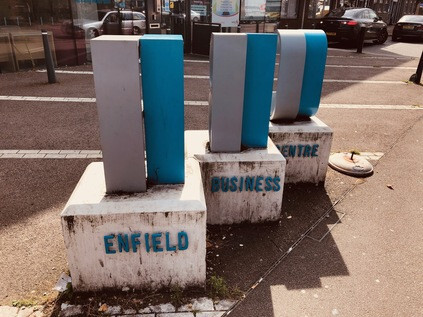
The remainder of the route was the familiar and much-trodden road into London - Dalston Junction, Kingsland Road, Norton Folgate - from desolation to gentrification, from market stalls to artisan street food. As I arrived under the towers of Bishopsgate and took a familiar snap of Christ Church Spitalfields at the end of Brushfield Street, a wedding party was setting off indigo-coloured smoke bombs across the street. The church was solid, reliable, and sinister. Seemingly more robust than the surrounding steel towers and glass-fronted bank headquarters. My walks into London via ancient thoroughfares always manage to explain the topography - they are often the paths of least resistance. Straight and flat. Complicated only by human interventions.
You can find photographs from the walk here.
It's not clear to me why I didn't finish this fairly advanced piece, which describes a wet but fulfilling walk along the canal from the far western edge of London into the city. Around this time I know I'd sold my laptop, and my opportunities to snatch moments to write in coffee shop corners were limited - but I'd clearly put a good deal of research into this. Perhaps if the urgency of the following month's political exorcism hadn't taken my time, and if the world hadn't descended into chaos just a few months later, I'd have completed the over-detailed and long-winded wander in text?
The piece starts with a rumination on anxiety. Shortly before this walk I'd begun to address this longstanding problem, finally conceding that I needed to seek help. I was at the beginning of a process which would bring great changes to my life over the next few years, and I can feel some of these inklings in my tone - there is more of me here, I'm not so afraid to express myself rather than hiding behind a 'voice' or a wall of facts. You, dear reader, may not see this - but for someone who had relentlessly pored over his work trying to eradicate any sense of self over the years, it is surprisingly honest and unvarnished.
The piece trails off in the shadow of Horsenden Hill, ruminating on modern mythmaking. My notes indicate that after this I planned to discuss Sainsbury's as the patron saint of canal walks (several are accessible directly from the towpath) and to explore the entry to the city, funnelled in between the Harrow Road and the Westway. I ended the walk passing under Trellick Tower - a beacon of arrival for so many journeys from the west, and into the soulless and bleak zone around Paddington basin.
2nd November 2019
The week before a planned walk, I'm usually unutterably anxious. The many variables which influence the success of an excursion conspire to present themselves for frequent evaluation: the performance of the railway network, financial stability, my health, and the weather. My life with anxiety is a complicated one involving a range of long-tested tools deployed to side-step its myriad sneak attacks and an endless and frustrating need for reassurance on impossible-to-test hypotheses. The central irony in this conundrum isn't lost on me - I know that walking improves my mental health, but I suffer great stress in the anticipation of the event. Today, only the weather had let me down with a forecast of heavy rain sweeping across the south. There was, it was predicted, a chance of some respite later - but it was remote and seemed increasingly unlikely as my train to London swished through a damp, misty landscape, the catenary crackling as we passed beneath. As ever, when faced with one of these much anticipated and fretted-upon challenges to my attempted walk having some impact on my plans, I resolved to largely ignore it. For all the worrying and fussing I'd undertaken and all the checking of the Met Office website, I planned to do exactly as I had set out to. Indeed, I planned to walk further. Seized by an urge to revisit an intersection with an earlier excursion, I made a swift turnaround at Paddington, dashing around the station quickly to make a train back to West Drayton. The skies were a gloomy rumble of purple-grey clouds, turbid and pregnant with the next downpour. It began just before my train arrived, exactly as predicted by the weather forecasters. I dashed for the waiting room which doubled as the station exit and prepared myself for a long, wet walk ahead.
West Drayton had provided a means of getting to the beginning of my walk on the A4, and while this meant it wasn't wholly unknown, it remained unfamiliar. I began walking down the station approach, passing the crumbling Moonlight Club, its name picked out in a string of long-extinguished fairy lights. The bridge over the canal was nearby - the railway and the waterway are often companions, but rarely more so than on the route I planned to take through these industrial zones of West London. I paused to look through the bars of the modern bridge parapet at the greenish water below, dappled with falling rain and reflecting the turbulent sky at me. It was time to get walking if I wanted to complete the ambitious itinerary I'd just decided to extend. Hood tight against the torrent, senses reduced to a forward view and muffled, distant sounds: stopping trains clattered to a halt nearby, while others screamed by at full speed, planes circled to approach Heathrow, distant traffic planed water off unseen road surfaces. But as soon as I was on the towpath of the canal, all fell silent but for my footfall.
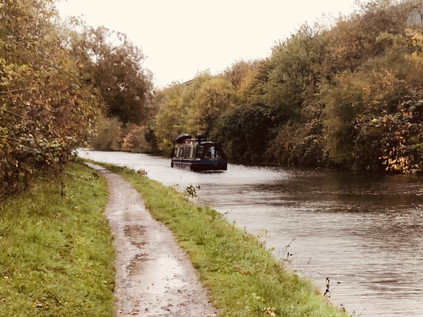
The Grand Junction Canal was authorised by an Act of Parliament in 1793, one of several potential schemes considered for a canal connecting the Thames, via the River Brent, to the Oxford Canal at Braunston. This would create a through-route to the burgeoning network of canals in Birmingham and the north of England - and beyond to the Irish Sea. Subsequent acts made provision for several 'arms' to connect to other waterways and significant towns along the Grand Junction's path. In 1795, a further bill additionally permitted the construction of a 13½ mile circuitous branch through the Middlesex countryside to terminate at a basin in the somewhat rural Paddington, then sitting on the fringe of London. By 1801 the main line of the canal, along with this branch, was open for business - changing the destiny of this once-bucolic swathe of England almost completely. Over the following century, the Grand Junction improved, modernised and consolidated with other Canals to become the Grand Union. Somehow this watery spine through middle England survived the coming of railways, motorways, and airports. It felt remarkable that the broad, still waterway continued to exist and could be used as a means of transport which largely served the same places it set out to in the Regency era. But now, of course, the towpath was quiet and the water entirely silent. Canals were places designated for sometimes expensive and exclusive leisure, but this one, carving through the distribution centres and business parks that flanked the western approaches to London had little scenic pull. The rain swirled around me, driving through my waterproof coat and whipping along the surface of the proud Grand Junction. The first stretch of the canal drove straight to the east, the Great Western Railway flanking the waterway to the south. The towpath was a narrow stony strip between the water and the grassy banks, still striated with red and gold autumnal foliage. Rain spattered from the broad leaves of the weed bank separating the canal from the back gardens and service yards beyond. This wasn't the ideal way to walk, but the satisfying crunch of the path under my boots was oddly mesmerising. Beyond the canal to the north was Stockley Park - once the seat of John Bennet, 1st Baron Ossulston who derived his manorial title from Ossulston Hundred, a sprawling division of the County of Middlesex now entirely subsumed into the suburbs of North West London. His seat was Dawley House, the grounds of which now provide the wide swathe of land housing the anodyne, glass and steel office park. Dawley and its surrounding farms had a remarkable and notable string of residents including Henry St. John, 1st Viscount Bolingbroke to whom the concept of a consistent parliamentary opposition is often credited. St. John employed architect James Gibbs to overhaul the house and garden designed by Charles Bridgeman to create a ferme ornée or ornamental farm, at which he was visited by Alexander Pope, Voltaire and Jonathan Swift. It seems the mighty Glaxo Smithkline and Marks & Spencer were not the first to create an artificial paradise of trees and lakes on these grounds. After St. John's death in 1751 the estate was acquired by the Earl of Uxbridge, greatly extending his holdings. Uxbridge commissioned a great wall around Dawley to keep smallpox at bay by preventing sufferers from entering his lands. Around 1779, Richard Tattersall began a stud farm near the boundary of the manor, known as Dawley Wall Farm, which provided the foundation of a business which remains the premier auction house for racehorses today. The estate finally passed to the de Salis family who slowly sold portions of the land during the 19th century. By the time the canal and railway arrived, the site of Dawley Wall Farm was a gravel pit which was perfectly situated to serve as a refuse tip, with barges of waste arriving to be offloaded and buried under the topsoil. Stockley Park, primped and perfectly green even on a rain-lashed November morning, is thus perhaps one of the earliest brownfield sites out here in the western suburbs. Dawley was the vanguard of lost villages of Middlesex: erased by the progress of London, gone before Heathrow could come to erase it.
Beyond the crossing of Dawley Road, the last ghost of the deleted hamlet, the terrain became more familiar. The canal crossed through the southernmost reaches of Hayes, dividing the town from its railway station and a triangle of tall, modern flats which had arisen between the railway and the canal. Cranes moved slowly across the skyline at the site of the former Nestlé works, slowly disappearing into the ground to rise again as new urban living opportunities. The rain whirled on the wind now that the empty horizon had nothing to prevent it from rushing along the line of the canal. The Parkway loomed overhead: the traffic barely visible but evident by the cacophony of gasping exhausts as brake lights rippled along the line of cars already slowing for the interchange at Cranford. Below the aqueduct I was crossing, the Yeading Brook was obscured by trees and weeds, swollen by the deluge but still remote and unreachable here. The land around the brook had been artificially raised by the toxic spoil of Bulls Bridge Power Station, long since demolished and now surviving only as a headache for developers building new industrial zones on the contaminant-rich soils. I passed under the road, feeling the inkling of some sort of pilgrimage forming. The A312 haunted me, and I was still considering its exorcism when I arrived almost unexpectedly at Bulls Bridge. The squat, white arch marked the entrance to the Paddington Arm - this was where I'd meant to start, and if I'd heeded the forecast I'd perhaps have been arriving in less of a bedraggled and waterlogged state. I dared to lower my hood to survey the surroundings. To the south, the view was dominated by supermarkets and warehouses - the flat, dull landscape of the Heathrow zone stretching into the distance. To the north, the branch of the canal broadened and swung to the northwest, striking out for the railway. The rain had slowed to a steady patter on the surface of the water, and there was the slightest hint of a pale sliver of white in the uniform grey of the cloud sheet. I dared to allow some optimism to creep into my view of the weather and struck out along the towpath.
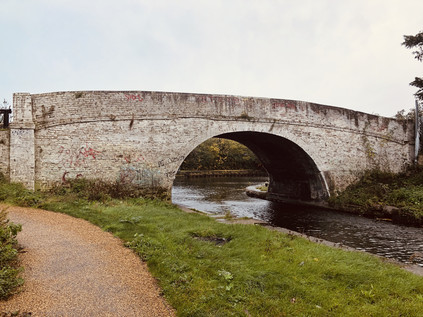
I began the seemingly interminable passage of the site of Southall's long-disused gasworks, still in the process of a long transformation into a new suburb. I'd passed this way a year ago, and little seemed to have changed - the site was still a plain of dirty brown earth with the striking form of the last blue gasholder drawing the eye along the railway. There had been some progress: the canal was now flanked with a solid perimeter fence where once a flimsy chainlink barrier had separated the unremediated ground from the water. Beyond, a new road struck out from Pump Lane, broad black tarmac forming a spine for a yet unborn village. Eventually, even the road gave up its attempts to impose order on the rust-coloured earth, which was turned into thick mud by the morning's downpour. The canal provided the hypotenuse of a triangle pointing due west, dotted with the ghostly impressions of decommissioned gas equipment which appeared like ritual circles. To the west, the green fringe of Minet Country Park edged the canal, hiding the tricky eastern course of the Yeading Brook in scrubby woodland. As I passed Blair Peach Primary School, named for the activist killed by Police Officers in Southall in 1979, the clouds finally parted to reveal blue skies flecked with white storybook clouds. Once again the weather had performed almost exactly as forecast. I counted my blessings for the almost unprecedented accuracy and weighed the options. I could peel off my dripping coat and stow it in my bag, or avoid an inevitable hex on my day and just walk it dry. I opted for the latter, there was no time to lose and a rare burst of Autumnal sunshine was never to be wasted. A terrace of canalside properties marked a return to civilization, as the Uxbridge Road - once the coaching route to Oxford, then the busy A40 - climbed overhead. Nearby, a local had turned up to feed the swans gliding along the now tranquil and blue-tinged surface of the water. He stood in a whirl of wings and crumbs, tossing slices of flaccid sliced bread into the breeze where they were snapped up before they'd landed. An advance guard of swans stalked the towpath, repelling any potential competition. As I nervously approached they began to advance with a low hiss and a determined stare. I decided to take a chance on the overground route, climbing up to road level beside the Hambrough Tavern, a decidedly 1960s pub built in squat and solid brick with a flat roof. The rather challenging crossing of the road remained preferable to attempt to navigate the maelstrom of birds and baked goods below, and as I descended back to the towpath via a slope leading down beside the Territorial Army centre, I could see the crowman continuing to toss a seemingly endless supply of old dough to the never satiated flurry. Aside from the avian excitement under the bridge, the canal was quiet - a far cry from its early days when this stretch ran alongside extensive brickworks serving the growing suburbs of London. The abandoned and repurposed sites form a stretch of pleasant and well-used greenspace along the western bank of the canal, dotted with ponds and small lakes which had filled the pits where clay had been extracted. There were also numerous docks and inlets along the canal here, and one of the larger wharves had been redeveloped into Willowtree Marina. Now a busy and prosperous over-wintering spot with on-site restaurants and services for boat-dwellers, it felt like a peaceful and calm zone now, and it was hard to envisage it teeming with noise and life as barges were loaded with brick destined for the city. A little further north, beyond the wide-open fields of Willow Tree Open Space, another inlet offered a different pace of moored life: Engineer's Wharf was surrounded by modern flats offering a waterside lifestyle with expensive restaurants on site. It felt busy, the boats overlooked by the anodyne housing units which leered over the pontoons. The canal felt like a curiosity here, and even further from the working waterway which it had so recently been. The colourful narrowboats ranked in the large, rectangular basin added colour and authenticity to the view from the high window - and no doubt value to the properties - though I wondered how many locals really regarded the canal and its associated towpath as anything more than a shortcut and a magnet for low-level crime in their otherwise respectable neighbourhood?

Leaving the former brickfields behind, the canal took a long slow turn to the east, winding around the edges of Greenford and narrowing to pass under Ruislip Road. The route of the canal, though somewhat ponderous, was a wonder of planning: despite navigating the hilly lowlands of West Middlesex there are no locks on the entire Paddington Arm. The canal slunk between suburban avenues in a chasm of mature trees which largely isolated me from my surroundings. Now that the sun had climbed above the remaining clouds the air was warm and I could feel my clothes beginning to dry. On the quiet towpath, distant sounds seemed closer and the thrum of the A40 hovered at the limit of perception. Between me and the road lay Marnham Fields: a broad triangle of woodland and rough grassland on the site of a former landfill, threaded with enticing paths which wound their way along the edge of the busy carriageway. As industrial uses for land around the canal declined, this part of the route has been allowed to return to nature as part of Northolt and Greenford Country Park. There was evidence of much care in the management of the woodland and despite the downpour earlier in the day, well-wrapped locals in high-end waterproof gear were out using the paths. To the west of the canal, a more recent initiative saw the creation of Northala Fields. Taking a name from one of the earliest incarnations of Northolt this modern park had replaced the Royal Borough of Kensington and Chelsea's recreation grounds. The new site sported a range of amenities but the most prominent were four huge conical mounds which aligned with Western Avenue and provided an acoustic barrier. One of the four mounds included a spiral trackway to its summit, and it was hard not to link these man-made vantage points with prehistoric activity in this long-settled corner of Middlesex. The mounds were in fact rooted in far more modern history, having been fashioned from the spoil of decidedly modern building projects such as the site clearance for the new Wembley Stadium. Perhaps the ceremonial internment of the hallowed turf on which England's World Cup victory took place wasn't a bad metaphor for the closure of the 20th century? In the paroxysm of national division which had dogged the past several years, such ancient history had been dusted off and rewritten. Blue passports and closed borders would reputedly secure a brighter future where trophies were apparently no longer out of our reach. From the nouveau barrows of Northala, the view over the land was hazy, indistinct and still reshaping in the brightening morning. Time would tell if this rebirth would rival 1966 - or would perhaps reprise 1666.
The concrete underpass carrying the Westway was lined with mosaics - an example of the kind of well-intentioned but soon forgotten civic project which so often decayed in these places. However, it was in surprisingly good shape and the stylised fish winked back at me in the sunshine as tyres screamed overhead. The contrast was striking, emerging from the green channel of the canal into this wide, flat world of rough, scrubby grass scythed in two by the great road. A bypass of the Uxbridge Road had been proposed as early as 1912 but the work was well underway by the arterial route boom of the 1920s. Western Avenue reached Denham by 1943, providing a continuous high-quality route from Hanger Lane to the edge of London. A motorway in all but legal standing, the broad carriageways shudder and twist through some of the surprisingly large tranches of green space that pepper the map of Ealing, a strategic route to Birmingham linked to the vast distribution and light industrial complexes of Park Royal. Intrigued and drawn as I am to these mighty expressions of the last century's motor boom, I wasn't sorry to pass by today. The rhythm and timbre of canal walks are entirely opposed to the enervating qualities of a road walk. I wasn't ready for that kind of pace or jeopardy. Today was about silent towpaths and crumbling warehouses. It was just what a walk in the closing months of a turbulent year should be.
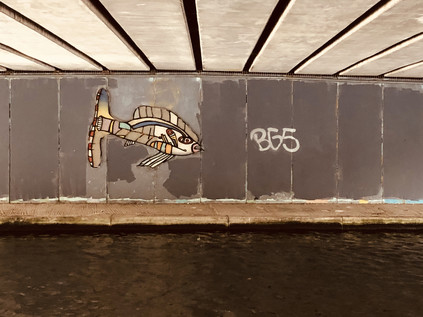
The canal made a valiant attempt to return to its slumbers after the road bridge, with a line of trees screening both banks from the sprawl of light industry which hugged its course through Greenford. After passing under the impressively solid girder bridges carrying the former Great Western Railway to the Midlands and the Central Line, the towpath rose to cross the entrance to a turbid, algae-covered basin which sat incongruously in a nook created by a corner of a huge DFS furniture distribution centre and Sotheby's Fine Art storage facility. This land once hosted the sprawling factories of J. Lyons and Co. which supplied both their successful teashops and the retail market. Connected to the dockland tea warehouses on the Thames via the canal and to the railway network for onward distribution, the site initially included tea and coffee blending plants, but variously expanded to provide cakes, pies, chocolate, jellies, and ice cream products. From the Greenford site, Lyons' supplied a network of restaurants, shops and later hotels using early computing technology to streamline their logistics and avoid wastage in the volatile perishable food supply chain. Now, the site was an anodyne sea of white warehouses and the kind of durable landscaping which is designed to stake out the boundaries between premises rather than provide any kind of aesthetic relief. I thought of the huge concrete cliff of the Tower Hotel in the distant city, once the jewel in the Lyons' crown and now supported by a basement coffee chain and a mock street food market on a carpet of fake grass blanketing the riverfront. The retail landscape has changed, but those who bemoan the preponderance of coffee shops have short memories - these third places were an indispensable feature of the social fabric long before the second-wave titans like Starbucks and Costa arrived on the scene. The Lyons Corner House is the social mainstay of mid-century literature, a safe place where men and women could meet without causing moral alarm, where an inexpensive meal could be found to sustain the straitened or fortify the troubled. The beating heart of this fallen empire, a pioneer of the kind of distribution network which these anonymous sheds now provided, now languished beneath the waters of this abandoned dock.
The canal began to buckle and weave along the 100' contour line, skirting the slopes of Horsenden Hill. These ancient slopes divide Sudbury from Ealing and essentially mark the psychic boundary between North and West London. There is evidence of an iron age hillfort at the summit of the hill which stakes out its strategic importance. Little changed in 2500 years, with gun emplacements installed in the second world war to defend the western industrial zones from enemy bombers. The hill, though prominent in the surprisingly level plain between the Crane and the Brent, is not high - but its situation gives commanding views over London from the west. Today there were pockets of walkers braving the muddy track to the pinnacle: like many such views around the city, winter is best - benefiting from a lack of foliage on the unmanaged trees of the woodland. The curves of the canal, in turn, feel old and abandoned, littered with houseboats which were summer projects, now largely boarded up and forgotten, whispering the guilt of a job unfinished is always far easier ignored than the call of a warm house. Above the lower slopes, now given over to sports pitches and golf courses, the wooded knob of the peak glowers over Middlesex - one of its oldest beacons. Horsenden Hill stands as a genuine and ancient counterpoint to the modern cairns at Northala Fields. Together they formed an unlikely gateway to the city and a portal between the pre-historic and the modern. Perhaps one day our descendent explorers will pick up the sense impressions of frustrated comedians chasing balls down those hills in the same way that the archaeology of Horsenden brings us closer to the iron age Britons who defended its slopes.
You can see more images from the walk here.
This fragment dates back to the Spring of 2019 - which seems like a lifetime ago. I had completed the London Ordinal walks, heading into the city along each of the ordinal routes, via a walk along the A5. As it was a shorter walk in some respects, I'd started a little further out of London. It was a surprisingly engaging walk considering I'd been concerned about the potential for a dull slog along familiar streets for a good part of the way. On my return though - I struggled to manage the idea that I'd actually completed something. I'd set out to walk each of the routes as a sort of thanksgiving for being able to continue my perambulations despite the financial challenges we faced at the turn of the year - and now it was done. My projects usually foundered, or were paused indefinitely when my attention wandered - but for once, I'd done exactly what I set out to.
The shock of this, along with the challenge of finding the next target, conspired to throw me into a spin. The write-up of the A4 walk had been long and somehow draining to write - not unlike walking the route. I was now without the same opportunities to commit time to write, and the piecemeal attempts to compose were stalling. Perhaps I'd finished more than just this project? Thus, the prospect of completing what I'd begun to write about the A5 became rather daunting. Committing to an ending wasn't my style. I was more worried about finding my next walk amongst a scrappy range of potential routes I'd been desperate to do when committed to a plan, but now couldn't seem to begin.
I did of course return to walking - and to writing, and this project faded into unconsidered obscurity. This fragment starts in Radlett, immediately plunging far too deeply into the detail, and seemed likely to meander considerably in defiance of the straight line of Watling Street. It stutters to a stop before reaching Elstree, hemmed in by the M1 and the A41 carving in from the west, and the last resting place of Nicholas Hawksmoor in nearby Shenley. The prospect of writing this landscape was just too daunting.
4th May 2019
When a project ends, it stirs all manner of disquiet. Was there really any point to this?
It's almost a century since the roads of Britain were first classified. Tamed into a network based on their prominence and strategic importance, the messy web of routes had - for the previous two decades at least - grown to meet the need of the emerging motorist. There were now enough cars and commercial vehicles on the road, making complex enough journeys between towns, to necessitate some sort of strategic approach beyond the County Council-sponsored fingerposts at the junction. The zoning and numbering of roads across Britain was the act of a determinedly modern post-war nation which was tooling up for the years to come. Arterial routes and bypasses emerged, carriageways were dualled and serious thought was given to the idea of express routes. Another great war and its comet-tail of economic depression would, of course, stamp itself squarely onto the country, squashing flat the ambition to improve the road network. When we emerged into the 1950s it was with optimism and drive, but little hard cash with which to engineer the kind of roads we needed. So, long-travelled lanes were upgraded, junctions were layered with signals and lights to help them resist growing traffic and even venerable Roman routes were pressed into greater use. The British road network lacks the impressive sea-to-shining-sea breadth of the US Interstates and can't touch the precision-engineered infrastructure of Central Europe's tunnels and bridges. But it has a surprising feeling of permanence and persistence: a sense that whether walked, cycled or driven, the user is part of a long story which isn't nearly finished yet. I set out on my last excursion in this short series with this in mind.
Leaving St. Pancras on a near-empty train which has departed, unexpectedly, from the open-air platforms on the upper concourse, I'm approaching another ending... When this year began on a cloudy, cold day in Hertfordshire I felt lucky just to be walking. The existential threat of a grim winter facing all kinds of difficulty and confusion was still reverberating in some sense. But for now, I was still out here pounding the footpaths and byways and it seemed fitting then that this trip would take me almost full circle - back into the leafy Home Counties north of London. I'd originally planned to disembark at Elstree and Borehamwood - the same place I'd thankfully set boots to tarmac back in January with a new project in mind - but the weather was fine, the day felt long given a relatively shorter planned walk ahead and I was keen to start from a new point. Radlett was unknown to me besides zipping through its station on the final approaches to London, knowing that the sometimes dull passage of the Midland Main Line was about to get interesting as the railway fell into step with the M1 and carved through the suburbs. Little did I think when I last flew by using Radlett as a marker that I'd plan to walk those last miles. But Radlett occupies a strategic location on what was - but now very much isn't - the A5, which was my focus today.
It is still, however, Watling Street and a short walk from the rather sleepy station took me onto the long, straight High Road which formed the spine of the town. Radlett radiated respectability and unaffordability in equal measure. The strong morning sunlight reflected from the road surface, winking back at me when it hit the shine of new cars nudging into roadside parking to access Budgens, Costa or the Synagogue. The little town, named for a crossing where roads met the ancient trackway to the north and west, was waking up on what seemed to be a very comfortable weekend morning.
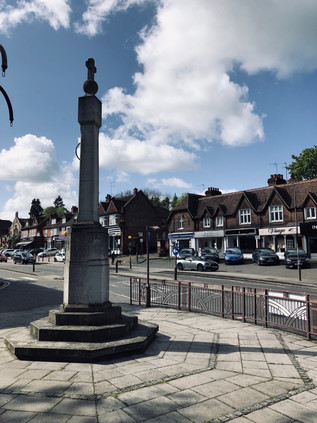
Radlett hadn't always enjoyed the reputation of quiet, respectable affluence it now possesses. In 1823 it achieved notoriety for the brutal murder of William Weare by John Thurtell. It is speculated that Thurtell owed Weare significant debts from gambling on illegal boxing matches and with no means to meet them, conspired instead to lure him into the countryside and shoot him. Invited to dine with him and his friends, Weare was ambushed on Gills Hill Lane and shot in the face. When the shot failed to despatch him Thurtell wrestled him to the ground, slit his throat and dashed his brains on the road using his pistol. With the body hidden in a nearby pond, Thurtell and his friends celebrated by singing and drinking. They later decided to move the body to a deeper lake in Elstree. The case was swiftly solved when the weapons were found and the pistol identified as one of a pair belonging to Thurtell, and such was the publicity that foreman of the Grand Jury William Lamb (later Prime Minister Lord Melbourne) despaired of a fair trial for the trio of conspirators. The gallows were already being erected when Thurtell's trial began, his accomplices William Probert and Joseph Hunt having cooperated with magistrates. He was, not unexpectedly hung in January 1864, soon after entering notoriety in contemporary ballads. Hunt's sentence was commuted and he forged a new life in Australia following transportation, while Probert was exonerated only to fall into a life of crime and later be hung for stealing horses. Despite being a discreet town encircled by the stranglehold of the Metropolitan Green Belt, Radlett still thrummed with the tension of the outer suburb. Curtains twitched as I passed by, and drivers took second glances at my unfamiliar face in the street. It was a town where anything out of the ordinary would still cause alarm. Safe and well-to-do, but poised on the brink: rehabilitated into respectability but mortally aware that its reputation is staked on remaining unknown and unremarkable. I rather liked the walk along the straight Roman high road passing the church with its haphazard lych gate. Radlett teetered on the edge of the high ground surrounding North London, a ring of low deprivation and high income which feeds the city with workers, and withdraws its wealth into the surrounding districts, reversing the natural flow of the Thames' tributaries. It felt like a good place to start walking...
All of the routes I'd hobbled along over the last few months of this strange project had seen change since their initial designation - some widened into almost-motorways or re-routed into concrete chasms to avoid ancient bottlenecks - but the A5 had suffered a far greater indignity. It had been entirely erased. As Radlett dwindled into its last few cottage outposts, the street name confirmed things: this was Watling Street. After arriving from Kent on the route of the A2, and a long lost and indistinct crossing of London, the route strikes out north and west towards the Midlands. A direct, diagonal slice across the map which had amazed and enchanted me as a child. This direct route had been defined by ancient Britons, fettled and improved by the Romans, and in parts adopted by Thomas Telford as his mail coach route to Holyhead and Ireland. But there was a problem with the modern A5 - it didn't actually go anywhere useful nowadays. After leaving London on the reverse of the route I was now walking, the A5 ploughed through the home counties to reach St. Albans which had been the strategically and economically important Roman city of Verulamium. Beyond St. Albans, the route skirted Dunstable and Luton, avoided Northampton and dodged to the north of Birmingham, not striking another substantial population centre until Shrewsbury. This made the route attractive for the development of new towns, with Milton Keynes and Telford both appearing and growing alongside it during the 20th century. As the strategic importance of the route had faded, this southern stretch of unimproved, rather old-fashioned rural A-road had been redesignated as the A5183, with London-bound traffic encouraged towards the M1. I decided that I'd break my unwritten rule...

There are more images from the walk in this gallery.
Lost::MikeGTN
I've had a home on the web for more years than I care to remember, and a few kind souls persuade me it's worth persisting with keeping it updated. This current incarnation of the site is centred around the blog posts which began back in 1999 as 'the daylog' and continued through my travels and tribulations during the following years.
I don't get out and about nearly as much these days, but I do try to record significant events and trips for posterity. You may also have arrived here by following the trail to my former music blog Songs Heard On Fast Trains. That content is preserved here too.
